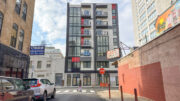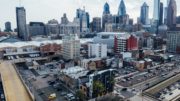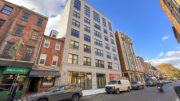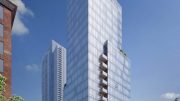In the mid-1980s, the Philadelphia skyline rose as an even, roughly 500-foot plateau, particularly when viewed from the north and south. Though the skyline spanned a great expanse length-wise, it remained at a low profile, in great part thanks to the “Gentlemen’s Agreement” to not build above the 548-foot-tall pinnacle of the City Hall, which sat just beneath the 37-foot-tall statue of William Penn, the state’s founder. Philly YIMBY presents exclusive massing renderings of the city skyline just as it appeared in 1985, just before One Commerce Square and One Liberty Place both broke ground, starting their challenge to the skyline in the summer.

Philadelphia skyline 1985 looking northwest. Image and models by Thomas Koloski

Philadelphia skyline 1985 looking northeast. Image and models by Thomas Koloski
The visuals provided show clearly that City Hall is the tallest structure in the city, as the William Penn statue stands above a lot of the towers from many views. The only structure that stands higher than City Hall is the antenna of the PSFS Building, standing at 794 feet tall though the height is not included. The Architects Building, now the Kimpton Hotel, used to have an antenna that brought the building to a height of 600 feet. Multiple highrises were built in the last five years as well, with most having floor to ceiling glass and stone.

Philadelphia skyline 1985 looking east. Image and models by Thomas Koloski

Philadelphia skyline 1985 looking southeast. Image and models by Thomas Koloski
One of the last towers built in the timeline was the 491-foot PNC Bank Building at 1600 Market Street, which features an all glass exterior that is black. Since the tower was completed in the same year Return of the Jedi released, the building had obtained the nickname “Darth Vader building” from the public as it was also inspired by its dark shiny glass. But just a year after, the 412 foot tall Jefferson Center, first known as One Reading Center, had just completed construction as it was clad with glass and stone as the structure features flat and curved faces as the building steps up to the roof that supports the company logos. But in the same year of the visuals, the 425-foot skyscraper at 1835 Market Street had just completed construction just to the north of 1818 Market Street.

Philadelphia skyline 1985 looking south. Image and models by Thomas Koloski

Philadelphia skyline 1985 looking west. Image and models by Thomas Koloski
The skyline shown in the visuals is what people of older generations rather prefer as they believe William Penn deserves more respect as he would stand above all of the structures to watch over the city. But, developers in the mid 1980’s rushed to plan their own skyscrapers as the proposal of One Liberty Place erased the Gentleman’s Agreement, as developers and the city though William Penn would rather have the city grow and progress for the future. Though the 500-foot limit is long gone, these visuals provide a great look at how the skyline has previously looked when the height restriction had City Hall at the top of the Philadelphia skyline.
Subscribe to YIMBY’s daily e-mail
Follow YIMBYgram for real-time photo updates
Like YIMBY on Facebook
Follow YIMBY’s Twitter for the latest in YIMBYnews






I hated the foolish “Gentlemen’s Agreement”.
It served no purpose whatsoever!
You couldn’t see the statue from 30th Street Station anyhow!
The ONLY reason for the height limit was because City Hall Tower was originally planned to be the world’s tallest skyscraper.
Although Chicago built the Home Insurance Building, first skyscraper in 1885 at 10 stories at 185 feet. It was demolished in 1931, the year of the Empire State Building which became the world’s tallest at the time.
Back to Philadelphia, in the 30 years it took to build City Hall in 1901, it was surpassed by the Washington Monument and the Eiffel tower.
philadelphiaencyclopedia.org
We made excuses for not expanding Els and Subways due to WW1,
the great depression and WII plus we blew a wonderful opportunity to extend the BSS to Northeast Philadelphia in 1964 due to racism issues.
I agree with the previous poster on why the Gentleman’s agreement to restrict building height as the real reason was of having your reputation eviscerated by those who behaved like the Know nothings.
Even today those of us who try to make clear the reasons for black on black crime is the selfish elements among their flock who cause trouble. Those of us who support the police are branded racist.
Yet we cannot get the Mayor and City Council to work like a team.
Thank you, James! 🙂
It’s no wonder why the Roosevelt Boulevard subway line halted construction at the old (demolished) Sears Tower.
The tunnel and station have been built, yet no publication wants to write about it or the history of the Market-Frankford line. During the expansion north, it was built alongside Interstate 95.
Those trains were remarkable!
I recall riding the old orange Broad Street cars before Kawasaki took over.
Transit America (Red Lion Road (Northeast Philadelphia)) used to build subway cars, but was ‘ railroaded’ out of business from the labor union. I worked at Transit America in the 80’s.
Do you remember the old Bridge Line connecting Camden to Philadelphia?
I recall a one-way fare costing 45¢ and a transfer costing 5¢.
There was skyscrapers planned for Philadelphia long before Rouse showed up.
In the 70’s, Mayor Rizzo was tough on crime, that’s for sure!
The bank presidents decided which buildings were going to get built along with Edmund Bacon.
Philadelphia has so much rich history that needs to be published.
When I was a teen, Center City was my playground.
Super Sunday on the Parkway.
So much fun! 😉